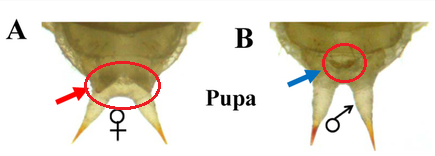Tribolium 102: Sexing Flour Beetles
Posted: November 26, 2012 Filed under: Identification | Tags: gender, genital papillae, identification, sexing, tribolium Leave a commentNow that we are familiar with identifying flour beetles out in the “field” and distinguishing them from other beetles, let’s level up our entomology stats and learn how to separate flour beetles by sex.
Adult male and female flour beetles are physically, nearly identical so the sexing of flour beetles is usually done in the pupal stage where males and females have prominent different features.
Let’s use the Confused Flour Beetle (Tribolium confusum) as example.
Flour beetles are tiny creatures and their appendages even smaller, so all sexing must be done under a light microscope. We want the beetle pupa to be on its back with the ventral side up.
Our focus is on the tip of the abdomen where there are 2 long projections called the urogomphi; both females and males have these protrusions. Layered on top the urogomphi and a little further up the abdomen is another set of 2 smaller projections called the genital papillae – this is what we will be looking at to distinguish between males and females.
On females, the genital papillae are pointy, with 2 darker dots on the tip of each, and roughly half the size of the urogomphi (they resemble tiny fingers).
On males, the genital papillae are stubby, conjoined, and barely noticeable. If female papillae resemble fingers, these look more like 2 conjoined thumbs.

Females have finger-like papillae (left), while males have stub-like projections (right). | Scientific Reports

References:
Park, Thomas. 1934. Observations on the General Biology of the Flour Beetle, Tribolium confusum. Quarterly Review of Biology, 9(1): 36-54.
Shukla, J.N. and Palli, S. R. 2012. Sex Determination in Beetles: Production of all male progeny by Parental RNAi knockdown of transformer. Scientific Reports, 2: 602.